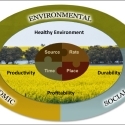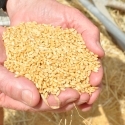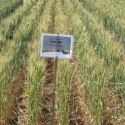11 Sep 2012
Where does Nitrogen fertilizer come from?
 Urea and urease treated urea
Urea and urease treated urea
Rob Mikkelsen, Western North American IPNI Director.
Rob Norton, Australia and New Zealand IPNI Director.
Nitrogen is one of the most widely distributed elements in nature since it is the most abundant gas in the atmosphere. But N is not found in mineral forms like P or K, but is largely present in organic compounds. When it is present in the soil, it is subject to many complex biological transformations that make it challenging to manage.
Nitrogen is essential for many metabolic processes in plants and animals. Perhaps the best-known role of N is in forming amino acids, which are the building blocks for protein. The human daily protein requirement ranges between 40 to 70 grams, depending on gender, age, and size. This protein will be around 16-18% N, depending on its origin.
Since the Haber-Bosch process for synthesizing N fertilizer was developed early in the 20th century, its importance in maintaining the global food supply has rapidly grown. It is estimated that half of the food produced now in the world is supported by the use of N fertilizer. Another way to look at this is that inside every cell, protein, or DNA molecule in your body, on average half of the N is a product of the Haber-Bosch process from a N fertilizer factory.
Globally around 100 million tonnes of synthetic N fertilizers are used annually to produce the food and fibre needed to support our population. This is expected to increase by around 27% by 2050, virtually in parallel to the rate of population growth. Over the past decade, average consumption of N in Australia has been around 940 thousand tonnes (kt) of N annually from domestically produced and imported sources. Over the past decade New Zealand used around 344 kt tonnes annually. The annual consumption was 367 kt in New Zealand (2010-2011) and 1,099 kt in Australia (2011).
All N fertilizer begins with a source of hydrogen gas and atmospheric N that are reacted to form ammonia. The most-used source of hydrogen is natural gas (methane). Other sources of hydrogen, such as coal, are used in some regions. After hydrogen and N are combined under conditions of high temperature and pressure to form ammonia, many other important N-containing fertilizers can then be made. Urea is the most common N fertilizer, but there are many excellent N fertilizers that can be made from ammonia. For example, some ammonia is oxidized to make nitrate fertilizer. This same conversion of nitrogen gas to ammonia/ammonium occurs in N fixing bacteria in the roots of legumes. The conversion of ammonia to nitrate takes place in agricultural soils through the microbial process of nitrification.
Because the production of hydrogen gas required for the synthesis of ammonia largely comes from natural gas, the price of this primary feedstock is the major factor in the cost of ammonia production. Ammonia factories sometimes close or open in various parts of the world in response to fluctuating gas prices. Higher energy costs always translate into higher prices for all N fertilizers.
There are a number of organic sources of N that are commonly used to fertilize crops. But remember that much of the N in animal manure, composts, and biosolids come from crops that received applications of fertilizer N. Therefore, the N in many organic fertilizers originated as inorganic N fertilizer.
Nitrogen fertilizers clearly make an essential contribution to maintaining an adequate supply of nutritious food. However, careful management is required to keep N fertilizer in the form and in the location where it can be most useful for sustaining healthy plant growth. The tremendous benefits from N fertilizer must be balanced with the disruptive environmental impacts that may arise when N moves into areas where it is not wanted.
A visual tour of the N fertilizer production process can be seen at: http://npg.ipni.net/article/NPG-3003
More can be found out about particular fertilizers - including various N sources at the Nutrient Source Specifics Portal at: http://www.ipni.net/specifics.




